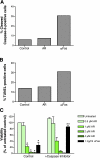Vitamin A depletion causes oxidative stress, mitochondrial dysfunction, and PARP-1-dependent energy deprivation
- PMID: 18676402
- PMCID: PMC2574026
- DOI: 10.1096/fj.08-112375
Vitamin A depletion causes oxidative stress, mitochondrial dysfunction, and PARP-1-dependent energy deprivation
Abstract
A significant unresolved question is how vitamin A deprivation causes, and why retinoic acid fails to reverse, immunodeficiency. When depleted of vitamin A, T cells undergo programmed cell death (PCD), which is enhanced by the natural competitor of retinol, anhydroretinol. PCD does not happen by apoptosis, despite the occurrence of shared early events, including mitochondrial membrane depolarization, permeability transition pore opening, and cytochrome c release. It also lacks caspase-3 activation, chromatin condensation, and endonuclease-mediated DNA degradation, hallmarks of apoptosis. PCD following vitamin A deprivation exhibits increased production of reactive oxygen species (ROS), drastic reductions in ATP and NAD(+) levels, and activation of poly-(ADP-ribose) polymerase (PARP) -1. These latter steps are causative because neutralizing ROS, imposing hypoxic conditions, or inhibiting PARP-1 by genetic or pharmacologic approaches prevents energy depletion and PCD. The data highlight a novel regulatory role of vitamin A in mitochondrial energy homeostasis.
Figures







Similar articles
-
Glucose deprivation converts poly(ADP-ribose) polymerase-1 hyperactivation into a transient energy-producing process.J Biol Chem. 2013 Dec 20;288(51):36530-7. doi: 10.1074/jbc.M113.506378. Epub 2013 Nov 5. J Biol Chem. 2013. PMID: 24194524 Free PMC article.
-
Caspase inhibition augments Dichlorvos-induced dopaminergic neuronal cell death by increasing ROS production and PARP1 activation.Neuroscience. 2014 Jan 31;258:1-15. doi: 10.1016/j.neuroscience.2013.11.004. Epub 2013 Nov 11. Neuroscience. 2014. PMID: 24231740
-
Inhibition of poly(ADP-ribose) polymerase activation attenuates beta-lapachone-induced necrotic cell death in human osteosarcoma cells.Toxicol Appl Pharmacol. 2002 Jul 15;182(2):116-25. doi: 10.1006/taap.2002.9438. Toxicol Appl Pharmacol. 2002. PMID: 12140175
-
Neuronal trauma model: in search of Thanatos.Int J Dev Neurosci. 2004 Nov;22(7):485-96. doi: 10.1016/j.ijdevneu.2004.07.015. Int J Dev Neurosci. 2004. PMID: 15465278 Review.
-
Glutamate excitotoxicity and Ca2+-regulation of respiration: Role of the Ca2+ activated mitochondrial transporters (CaMCs).Biochim Biophys Acta. 2016 Aug;1857(8):1158-1166. doi: 10.1016/j.bbabio.2016.04.003. Epub 2016 Apr 7. Biochim Biophys Acta. 2016. PMID: 27060251 Review.
Cited by
-
The RARγ Oncogene: An Achilles Heel for Some Cancers.Int J Mol Sci. 2021 Mar 31;22(7):3632. doi: 10.3390/ijms22073632. Int J Mol Sci. 2021. PMID: 33807298 Free PMC article. Review.
-
Quantum chemistry rules retinoid biology.Commun Biol. 2023 Feb 28;6(1):227. doi: 10.1038/s42003-023-04602-x. Commun Biol. 2023. PMID: 36854887 Free PMC article. Review.
-
Regulation of intermediary metabolism by the PKCdelta signalosome in mitochondria.FASEB J. 2010 Dec;24(12):5033-42. doi: 10.1096/fj.10-166934. Epub 2010 Aug 26. FASEB J. 2010. PMID: 20798245 Free PMC article.
-
Retinoic Acid Prevents α-Synuclein Preformed Fibrils-Induced Toxicity via Inhibiting STAT1-PARP1 Signaling.Mol Neurobiol. 2023 Aug;60(8):4828-4841. doi: 10.1007/s12035-023-03376-x. Epub 2023 May 12. Mol Neurobiol. 2023. PMID: 37171576
-
Synergistic effect and mechanism of vitamin A and vitamin D on inducing apoptosis of prostate cancer cells.Mol Biol Rep. 2013 Apr;40(4):2763-8. doi: 10.1007/s11033-012-1925-0. Epub 2013 Feb 23. Mol Biol Rep. 2013. PMID: 23436065
References
-
- De Luca L M. Retinoids and their receptors in differentiation, embryogenesis, and neoplasia. FASEB J. 1991;5:2924–2933. - PubMed
-
- Buck J, Derguini F, Levi E, Nakanishi K, Hammerling U. Intracellular signaling by 14-hydroxy-4,14-retro-retinol. Science. 1991;254:1654–1656. - PubMed
-
- Derguini F, Nakanishi K, Hammerling U, Chua R, Eppinger T, Levi E, Buck J. 13,14-Dihydroxy-retinol, a new bioactive retinol metabolite. J Biol Chem. 1995;270:18875–18880. - PubMed
-
- Derguini F, Nakanishi K, Hammerling U, Buck J. Intracellular signaling activity of synthetic (14R)-, (14S)-, and (14RS)-14-hydroxy-4,14-retro-retinol. Biochemistry. 1994;33:623–628. - PubMed
Publication types
MeSH terms
Substances
Grants and funding
LinkOut - more resources
Full Text Sources
Other Literature Sources
Research Materials
Miscellaneous

